25-functions.ppt
- 1. CSE 341 Lecture 25 More about JavaScript functions slides created by Marty Stepp http://www.cs.washington.edu/341/
- 2. 2 First-class functions ? JS functions are first-class objects. You can: ? store a (reference to a) function in a variable ? create an array of functions ? use a function as a property of an object (a method) ? pass a function as a parameter; return a function ? write functions that take varying numbers of parameters ? write higher-order functions (that take others as params) ? define functions inside functions (nested functions) ? define anonymous functions (lambdas) ? store properties inside functions
- 3. 3 Defining a function function name(paramName, ..., paramName) { statements; } ? example: function sumTo(n) { var sum = 0; for (var i = 1; i <= n; i++) { sum += i; } return sum; }
- 4. 4 Returning values function maybeReturn(n) { if (n % 2 == 0) { return "even"; } // else return undefined } ? parameter and return types are not declared ? the function can return anything it wants ? if a function returns nothing, it returns undefined ? a function can sometimes return values and sometimes not
- 5. 5 Calling a function functionName(expr, ..., expr) ? example: ? sumTo(6) // returns 21 ? extra parameters passed are ignored: ? sumTo(3, "hello", null, 42) // returns 6 ? expected parameters not passed are undefined : ? sumTo() // returns 0
- 6. 6 Optional parameters function greet(name, msg) { if (typeof(msg) === "undefined") { msg = "Hello"; } print(msg + " to you, " + name); } > greet("Bob", "Good day"); Good day to you, Bob > greet("Sue"); Hello to you, Sue ? to have an optional parameter, check whether it is defined
- 7. 7 Object as argument specifier function mealCost(argObj) { var amt = argObj["subtotal"]; if (argObj["tax"]) { amt *= 1 + argObj["tax"]; } if (argObj["tip"]) { amt *= 1 + argObj["tip"]; } if (argObj["donation"]) { amt += argObj["donation"]; } return amt; } > mealCost({subtotal: 50.0, tip: .15}) 57.5 > mealCost({subtotal: 10.0, tax: .08, donation: true}) 11.8 ? specify many parameters as properties of a single object ĻC can pass many args in any order; optional args; clear naming ĻC this style is seen in JavaScript libraries (jQuery, Prototype)
- 8. 8 Variadic functions (var-args) function addAll() { var sum = 0; for (var i = 0; i < arguments.length; i++) { sum += arguments[i]; } return sum; } ? addAll(1, 7, 4, 3) returns 15 ? addAll(1, 2, "3", 4, 5) returns "3345" ? each function has an array property* named arguments that stores all parameter values passed to it ? can be used to create variadic (var-args) functions * actually a duck-typed array-like object with a length field
- 9. 9 Anonymous functions (lambdas) function(paramName, ..., paramName) { statements; } ? anonymous functions can be stored, passed, returned > function foo(x, f) { return f(x) + 1; } > foo(5, function(n) { return n * n; }) 26 ? Exercise: Sort an array of strings case-insensitively. ? Exercise: Sort an array of names by last, then first, name.
- 10. 10 Two ways to declare a function ? The following are equivalent: function name(params) { var name = function(params) { statements; statements; } } var squared = function(x) { return x*x; };
- 11. 11 Array higher-order functions * * most web browsers are missing some/all of these methods .every(function) accepts a function that returns a boolean value and calls it on each element until it returns false .filter(function) accepts a function that returns a boolean; calls it on each element, returning a new array of the elements for which the function returned true .forEach(function) applies a "void" function to each element .map(function) applies function to each element; returns new array .reduce(function) .reduce(function, initialValue) .reduceRight(function) .reduceRight(function, initialValue) accepts a function that accepts pairs of values and combines them into a single value; calls it on each element starting from the front, using the given initialValue (or element [0] if not passed) reduceRight starts from the end of the array .some(function) accepts a function that returns a boolean value and applies it to each element until it returns true
- 12. 12 Higher-order functions in action > var a = [1, 2, 3, 4, 5]; > a.map(function(x) { return x*x; }) 1,4,9,16,25 > a.filter(function(x) { return x % 2 == 0; }) 2,4 ? Exercise: Given an array of strings, produce a new array that contains only the capitalized versions of the strings that contained 5 or more letters.
- 13. 13 Nested functions // adds 1 to each element of an array of numbers function incrementAll(a) { function increment(n) { return n + 1; } var result = a.map(increment); return result; } ? functions can be declared inside of other functions ? the scope of the inner function is only within the outer one
- 14. 14 Invocation patterns ? functions can be invoked in four ways in JavaScript: ? as a normal function ? as a method of an object ? as a constructor ? through their apply property
- 15. 15 Functions as methods ? an object's methods are just properties that are functions ? the function uses the this keyword to refer to the object > var teacher = { name: "Tyler Durden", salary: 0.25, greet: function(you) { print("Hi " + you + ", I'm " + this.name); }, toString: function() { return "Prof. " + this.name; } }; > teacher.greet("kids"); Hi kids, I'm Tyler Durden
- 16. 16 Function binding { ... propertyName: function, // bind at ... // declaration } object.propertyName = function; // bind later ? when a function is stored as a property of an object, a copy of that function is bound to the object ? calling the function through that object will cause that object to be used as this during that particular call ? if you don't call the function through the object, that object won't be used as this
- 17. 17 The this keyword function printMe() { print("I am " + this); } > teacher.print = printMe; > teacher.print(); I am Prof. Tyler Durden > printMe(); I am [object global] > ({p: printMe}).p() I am [object Object] > var temp = teacher.print; > temp(); I am [object global]
- 18. 18 Aside: Web event handlers <button id="b1">Click Me</button> HTML var b1 = document.getElementById("b1"); JS b1.onclick = function() { ... }; ? most JavaScript code in web pages is event-driven ? elements in the HTML have events that can be handled ? you specify a JS function to run when the event occurs ? the function can access/modify the page's appearance
- 19. 19 Invoking with apply func.apply(thisObj, arguments); ? You can call a function using its apply property ? allows you to set this to be anything you want ? allows you to pass a function its arguments as an array var o = ({toString: function(){return "!"}}); > apply(printMe, o, []); I am ! Exercise: Write a function callBoth that takes two functions and an array of parameters and calls both, passing them those parameters, and printing both results.
- 20. 20 Composing functions function compose(f, g) { return function() { return f(g.apply(this, arguments)); }; } ? JavaScript has no built-in syntax for composing functions ? but you can use apply to write a helper for composition
- 21. 21 How to curry functions function toArray(a, i) { // converts a var result = [], i = i || 0; // duck-typed obj while (i < a.length) { // into an array result.push(a[i++]); } return result; }; function curry(f) { // Usage: curry(f, arg1, ...) var args = toArray(arguments, 1); // remove f return function() { return f.apply(this, args.concat(toArray(arguments))); }; } ? JavaScript doesn't include syntax for currying functions ? but we can add such functionality ourselves
- 22. 22 Methods of Function objects .toString() string representation of function (its code, usually) .apply(this, args) calls a function using the given object as this and passing the given array of values as its parameters .call(this, arg1, ...) var-args version of apply; pass args without array .bind(this) attaches the function's this reference to given obj
- 23. 23 A JS library: Underscore http://documentcloud.github.com/underscore/ ? Adds functional language methods to JavaScript. ? Collections: each, map, reduce, reduceRight, detect, select, reject, all, any, include, invoke, pluck, max, min, sortBy, sortedIndex, toArray, size ? Arrays: first, rest, last, compact, flatten, without, uniq, intersect, zip, indexOf, lastIndexOf, range ? Functions: bind, bindAll, memoize, delay, defer, wrap, compose ? Objects: keys, values, functions, extend, clone, tap, isEqual, isEmpty, isElement, isArray, isArguments, isFunction, isString, isNumber, isBoolean, isDate, isRegExp, isNaN, isNull, isUndefined ? Utility: noConflict, identity, times, breakLoop, mixin, uniqueId, template ? Chaining: chain, value > _([1, 4, 2, 7, 3, 5]).max() 7
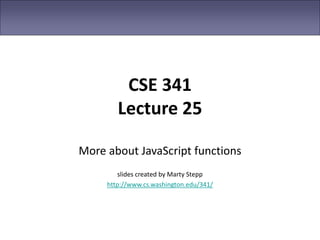





![7
Object as argument specifier
function mealCost(argObj) {
var amt = argObj["subtotal"];
if (argObj["tax"]) { amt *= 1 + argObj["tax"]; }
if (argObj["tip"]) { amt *= 1 + argObj["tip"]; }
if (argObj["donation"]) { amt += argObj["donation"]; }
return amt;
}
> mealCost({subtotal: 50.0, tip: .15})
57.5
> mealCost({subtotal: 10.0, tax: .08, donation: true})
11.8
? specify many parameters as properties of a single object
ĻC can pass many args in any order; optional args; clear naming
ĻC this style is seen in JavaScript libraries (jQuery, Prototype)](https://image.slidesharecdn.com/0stda1vurnosfpeonubv-25-functions-230417040357-17715631/85/25-functions-ppt-7-320.jpg)
![8
Variadic functions (var-args)
function addAll() {
var sum = 0;
for (var i = 0; i < arguments.length; i++) {
sum += arguments[i];
}
return sum;
}
? addAll(1, 7, 4, 3) returns 15
? addAll(1, 2, "3", 4, 5) returns "3345"
? each function has an array property* named arguments
that stores all parameter values passed to it
? can be used to create variadic (var-args) functions
* actually a duck-typed array-like object with a length field](https://image.slidesharecdn.com/0stda1vurnosfpeonubv-25-functions-230417040357-17715631/85/25-functions-ppt-8-320.jpg)


![11
Array higher-order functions *
* most web browsers are missing some/all of these methods
.every(function) accepts a function that returns a boolean value
and calls it on each element until it returns false
.filter(function) accepts a function that returns a boolean; calls it
on each element, returning a new array of the
elements for which the function returned true
.forEach(function) applies a "void" function to each element
.map(function) applies function to each element; returns new array
.reduce(function)
.reduce(function,
initialValue)
.reduceRight(function)
.reduceRight(function,
initialValue)
accepts a function that accepts pairs of values and
combines them into a single value; calls it on each
element starting from the front, using the given
initialValue (or element [0] if not passed)
reduceRight starts from the end of the array
.some(function) accepts a function that returns a boolean value
and applies it to each element until it returns true](https://image.slidesharecdn.com/0stda1vurnosfpeonubv-25-functions-230417040357-17715631/85/25-functions-ppt-11-320.jpg)
![12
Higher-order functions in action
> var a = [1, 2, 3, 4, 5];
> a.map(function(x) { return x*x; })
1,4,9,16,25
> a.filter(function(x) { return x % 2 == 0; })
2,4
? Exercise: Given an array of strings, produce a new array that
contains only the capitalized versions of the strings that contained
5 or more letters.](https://image.slidesharecdn.com/0stda1vurnosfpeonubv-25-functions-230417040357-17715631/85/25-functions-ppt-12-320.jpg)

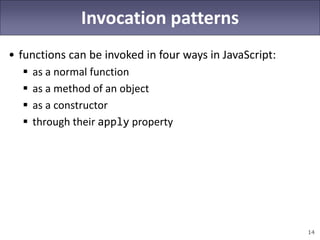


![17
The this keyword
function printMe() {
print("I am " + this);
}
> teacher.print = printMe;
> teacher.print();
I am Prof. Tyler Durden
> printMe();
I am [object global]
> ({p: printMe}).p()
I am [object Object]
> var temp = teacher.print;
> temp();
I am [object global]](https://image.slidesharecdn.com/0stda1vurnosfpeonubv-25-functions-230417040357-17715631/85/25-functions-ppt-17-320.jpg)

![19
Invoking with apply
func.apply(thisObj, arguments);
? You can call a function using its apply property
? allows you to set this to be anything you want
? allows you to pass a function its arguments as an array
var o = ({toString: function(){return "!"}});
> apply(printMe, o, []);
I am !
Exercise: Write a function callBoth that takes two functions
and an array of parameters and calls both, passing them
those parameters, and printing both results.](https://image.slidesharecdn.com/0stda1vurnosfpeonubv-25-functions-230417040357-17715631/85/25-functions-ppt-19-320.jpg)

![21
How to curry functions
function toArray(a, i) { // converts a
var result = [], i = i || 0; // duck-typed obj
while (i < a.length) { // into an array
result.push(a[i++]);
}
return result;
};
function curry(f) { // Usage: curry(f, arg1, ...)
var args = toArray(arguments, 1); // remove f
return function() {
return f.apply(this,
args.concat(toArray(arguments)));
};
}
? JavaScript doesn't include syntax for currying functions
? but we can add such functionality ourselves](https://image.slidesharecdn.com/0stda1vurnosfpeonubv-25-functions-230417040357-17715631/85/25-functions-ppt-21-320.jpg)
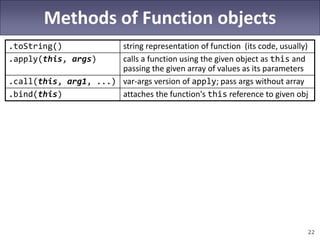
![23
A JS library: Underscore
http://documentcloud.github.com/underscore/
? Adds functional language methods to JavaScript.
? Collections: each, map, reduce, reduceRight, detect, select, reject, all, any,
include, invoke, pluck, max, min, sortBy, sortedIndex, toArray, size
? Arrays: first, rest, last, compact, flatten, without, uniq, intersect, zip, indexOf,
lastIndexOf, range
? Functions: bind, bindAll, memoize, delay, defer, wrap, compose
? Objects: keys, values, functions, extend, clone, tap, isEqual, isEmpty,
isElement, isArray, isArguments, isFunction, isString, isNumber, isBoolean,
isDate, isRegExp, isNaN, isNull, isUndefined
? Utility: noConflict, identity, times, breakLoop, mixin, uniqueId, template
? Chaining: chain, value
> _([1, 4, 2, 7, 3, 5]).max()
7](https://image.slidesharecdn.com/0stda1vurnosfpeonubv-25-functions-230417040357-17715631/85/25-functions-ppt-23-320.jpg)







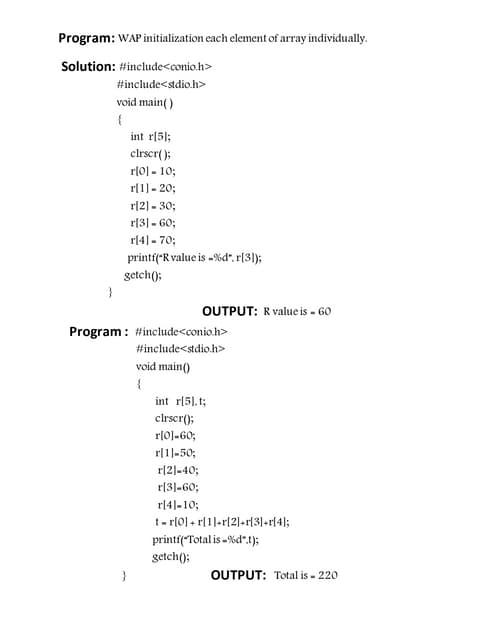





















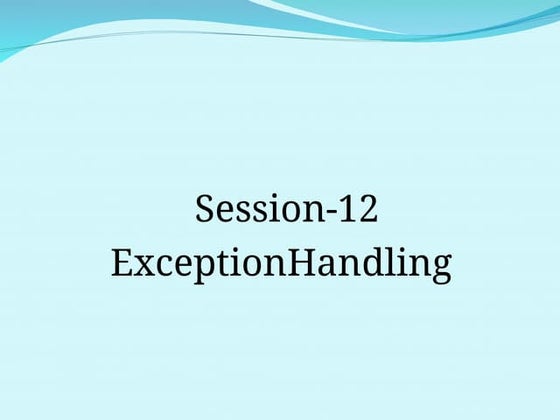


























![Windows 8.1 Pro Activator Crack Version [April-2025]](https://cdn.slidesharecdn.com/ss_thumbnails/lecture9-250228130043-bd676d0e-250401141425-60508047-250401150607-9cd2b2bd-thumbnail.jpg?width=560&fit=bounds)









